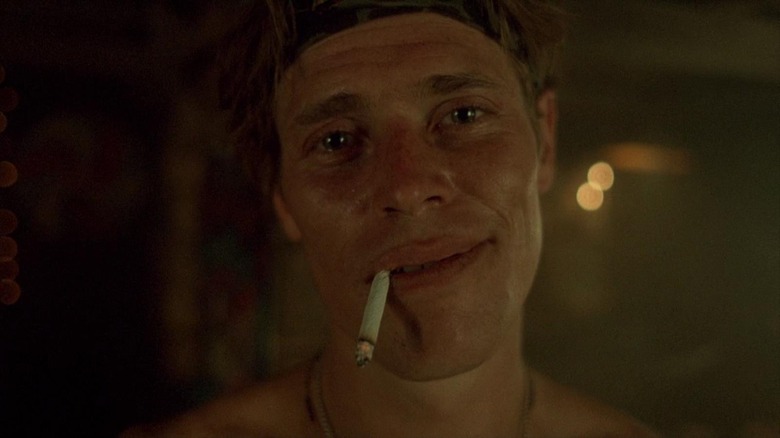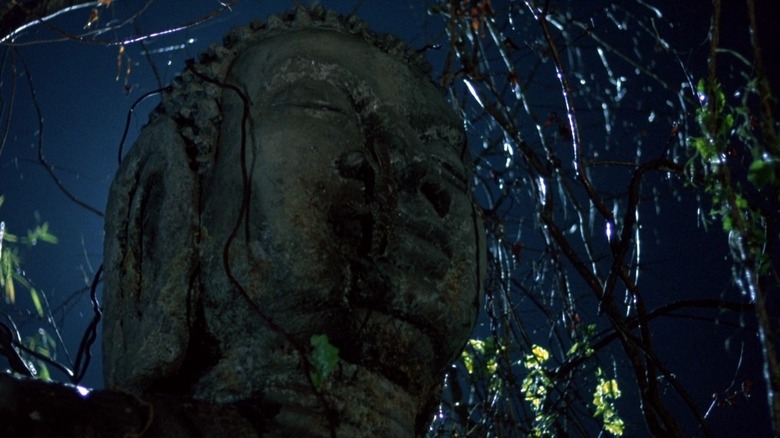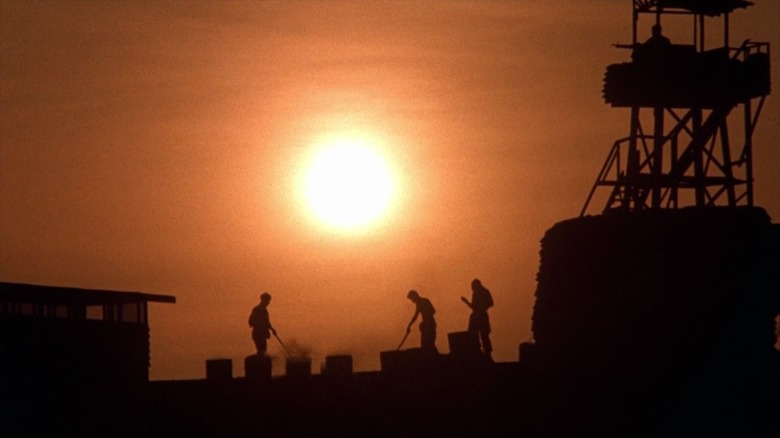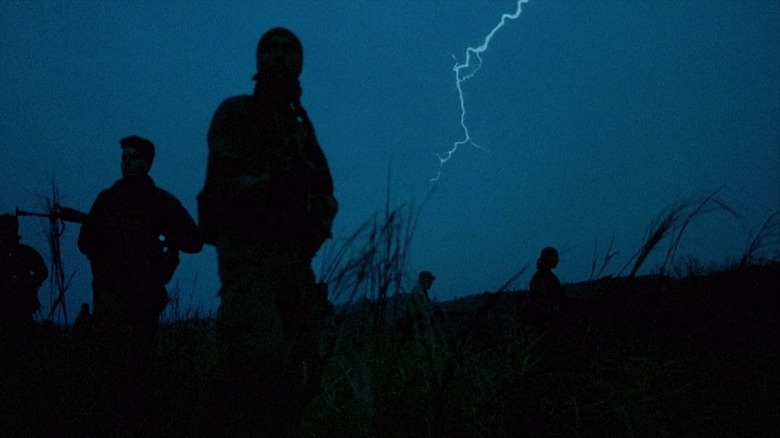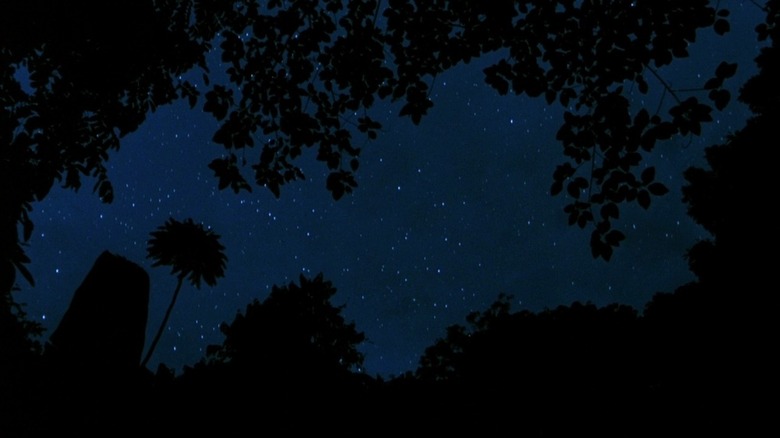How Political Revolution Threatened Platoon's Production In The Philippines
"Platoon" was a challenging film to make. Oliver Stone had served in the Vietnam War and was intent on getting it right on screen. Few others shared his vision. The Pentagon not only refused him funding, but put out a warning to their personnel urging them not to cooperate. As for Hollywood, Stone said to ABC News in Australia, they "did not want to make this subject matter ... realism was not of interest to them." The time for serious war films like "Apocalypse Now" had passed. But while Stone had enough on his plate managing the release of his most recent project, the troubled "Salvador," he refused to give up on "Platoon." The film's production had already fallen through once in 1976, and again in 1984. If the movie was ever going to be made, this was it. Stone would make "Platoon" for just $6 million in 54 days, and he would do it in the Philippines.
To accomplish this, Stone made some risky choices. He hired Dale Dye, an ex-marine and "detail freak" obsessed with recreating the Vietnam battlefield exactly as it was. He required that the cast endure basic training with Dye in the Filipino forests so that they would understand something of what he suffered in Vietnam. He barely slept during filming, and according to interviews skimped on safety by "[blowing] up a lot of stuff very close to people." It was a set where Forest Whittaker nearly cut off his thumb trying to split a coconut in half with a machete. A set where Willem Dafoe was medevaced after drinking from a tainted stream. These stories made for spicy material come Oscar season. But the greatest challenge the film faced had nothing to do with any of them. The tumultuous production of "Platoon" was just a footnote to the main event of February 1986: the People Power Revolution, the most famous popular revolution in the history of the Philippines.
The cruelty of Ferdinand Marcos
Since 1965, the Philippines had been run by president Ferdinand Marcos. Marcos was deeply corrupt, using the power of the government to enrich himself and his friends. He declared martial law in 1972, beginning over a decade of terror. According to the data, 3,257 people were killed. 2,520 of these were "salvaged," tortured to death, and left in the gutters for their neighbors to find. 35,000 were tortured and 70,000 incarcerated. Those who disapproved of the regime, whether they be leftists or moderates, were tarred with the same red brush. The United States encouraged this. In the minds of presidents like Bush Sr. or Reagan, a fascist Filipino president was better than a Communist. The International Monetary Fund and the World Bank continued to offer Marcos loans, from which Marcos would take his share.
But the 1980s saw the influence of Marcos and his generals begin to slip. The assassination of Marcos's rival, Senator Benigno Aqunio Jr., led to an outpouring of grief and outrage across the country. His wife, Cory Aquino, became a popular public figure and the logical successor to Aquino Jr.'s legacy. Filipino leftists had already laid the groundwork inside and outside the country over the past several years, organizing protests everywhere from the cities of the Philippines to the streets of Washington DC. Most notably of all, the Catholic archbishop of the Philippines, Jaime Cardinal Sin, turned the full force of the country's most powerful cultural institution against Marcos's presidency. Marcos called a snap election in 1985, hoping to crush Aquino in the polls – or at least pretend to. His own people called the election in his favor, but Aquino clearly had greater popular support. In a sea of opposing views and possible futures, the one thing a critical mass of people could agree on was their disgust for the Marcos government.
Birth of the People Power Revolution
As part of preparing to film "Platoon" in the Philippines, Oliver Stone had made deals with the military to secure the use of equipment. But the Filipino military found itself in turmoil. A movement within the army called the RAM (Reform the Armed Forces) sought to overthrow the Marcos presidency from within. When the Marcos government smoked out armed officials they claimed were instigating a coup, Defense Minister Juan Ponce Enrile and Lieutenant General Fidel Ramos sensed blood in the water and chose to turn against the Marcos regime entirely. They holed up at Camp Aguinaldo, the headquarters of the Armed Forces of the Philippines. Right nearby was Epifanio de Los Santos Avenue, or EDSA, a massive highway cutting through the capital city Manila. Marcos demanded his loyal soldiers seize Aguinaldo, Cardinal Sin called for citizens to support Enrile and Fidel, and Filipinos of all ages came out to EDSA to physically block the path to Enrile and Ramos with their bodies. This was February 22, 1986, the birth of the People Power Revolution.
Oliver Stone had known for some time that he could not make a movie at a time like this. Rather than cancel the production and risk losing the film entirely, he chose to postpone its start date to March 20. Behind the scenes, actors were cast and recast as they grappled with politics on the ground as well as the future of what was to be a bizarre, demanding shoot. Some members of the cast, like Willem Dafoe, had already arrived in the Philippines and sent back word of movement on the city streets. With the negative critical reception to "Salvador" at Cannes, and "Platoon" on life support in the midst of a political revolution, it was a difficult time to be Oliver Stone.
The escape of Ferdinand Marcos
In his memoir "Chasing the Light," excerpted in GQ, Stone explains why funding "Platoon" was such a challenge. He names:
"a sort of manufactured intellectual 'neoliberalism,' worshipful of capitalism, which would be identified with empire, Nato and the Western military alliance, strongly tied to the World Bank and IMF economic controls."
It is true that countries like the Philippines were heavily influenced by loans from the World Bank and the IMF. The institutions of neoliberalism were willing to let people suffer so long as the country remained plausibly capitalist. Only a filmmaker as stubborn as Oliver Stone could shout over that fearful solipsism. That said, I can't help but wonder if Stone understood his own complicity as a part of that system. He might have styled himself a provocateur, but at the end of the day, he was an American director shooting his film in a country under the thumb of the United States. Stone chose the Philippines so as to approximate the Vietnam jungle, but I have to assume that he also chose the Philippines because it was cheap.
Marcos blinked first in the end. Advised by Reagan ally Senator Paul Laxalt to "cut, and cut cleanly," the president and his family evacuated the country by helicopter with the help of the United States on February 25, 1986. The people of the Philippines had taken their country back from autocracy with hardly any bloodshed. But the story wasn't over. Aquino endured multiple coups as president, and eventually turned against the liberal wing of her supporters in favor of the conservatism of later-president Fidel Ramos. As for Stone, he was able to arrange new deals with the military for helicopters and other equipment. These helicopters, he would tell Entertainment Weekly in 2011, were not very well maintained. "I was happy for the people in the Philippines ... but it really threatened our shoot."
Legacy of the People Power Revolution
Since February 1986, the institutional neoliberalism that Stone described in his memoir remains bloody but unbowed in the face of worldwide contagion, protest, and rising fascism. In 2016, the Filipino people elected the deeply nasty and cruel Rodrigo Duterte over his liberal rival Mar Roxas. Roxas was the hand-picked successor of former president Benigno Aquino III, who despite speaking of himself as a "public servant" was thought by some to have pursued policies benefiting the wealthy elite over the working class. The legacy of the People Power Revolution is debated to this day. What unfinished business remains in its aftermath? Did those advocating change at that time live up to their responsibilities?
In the meantime, the Marcos family continues to creep back towards the levers of power. Bongbong Marcos, Ferdinand's only son, is running for president together with Duterte's daughter in 2022. "People no longer ask about martial law," Bongbong has said. "They are interested in current problems of the country, such as jobs and traffic." There are certainly those in the country who agree with him, and believe that the Marcos regime was not a disgrace but a golden age. But there are also those who disagree. "It was a 'golden age' if you were politically aligned with Marcos," says Raissa Robles, journalist. "The cronies and warlords of Marcos lived well and got the best of everything, but not the rest of society."
Today in the Philippines there are writers, activists, and filmmakers who are laboring to puncture the myths created by those in power. As they are doing now, and as Stone aspired to do in 1986, each of us has a responsibility to expose the injustices of the past rather than obscure them. It may be our only hope of surviving the complicated future ahead, together, without losing our dignity.
